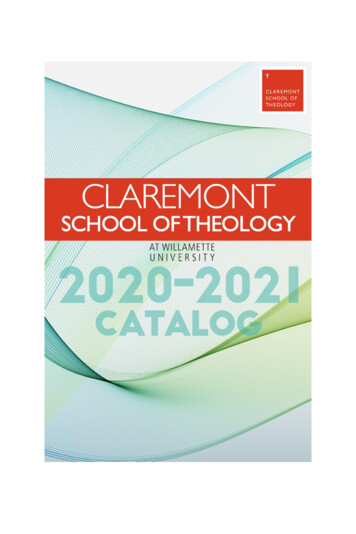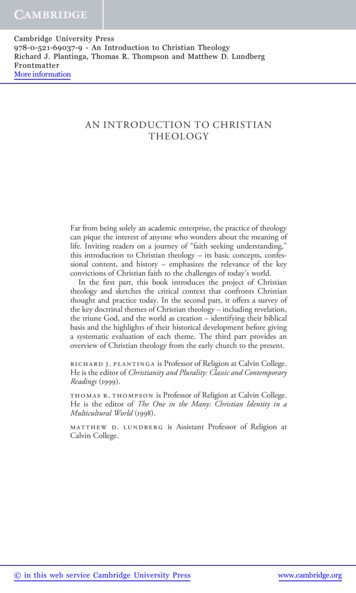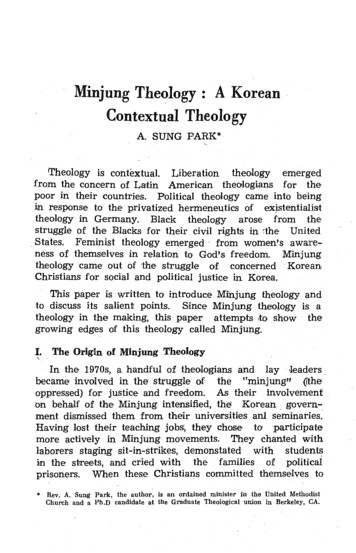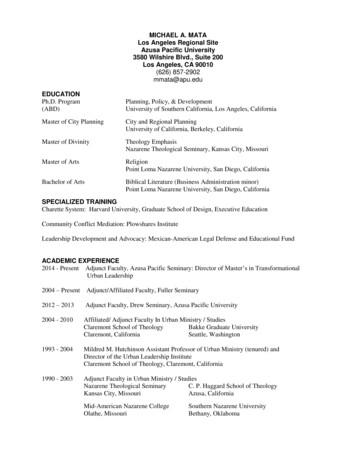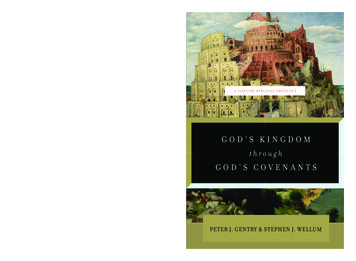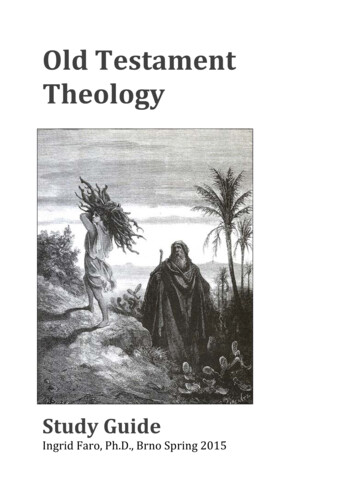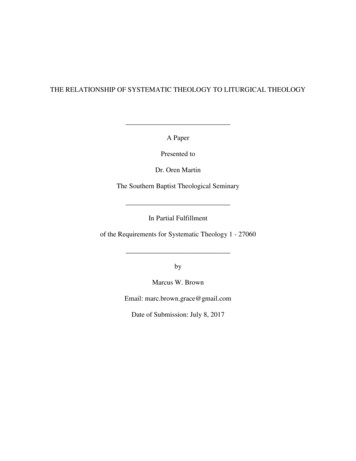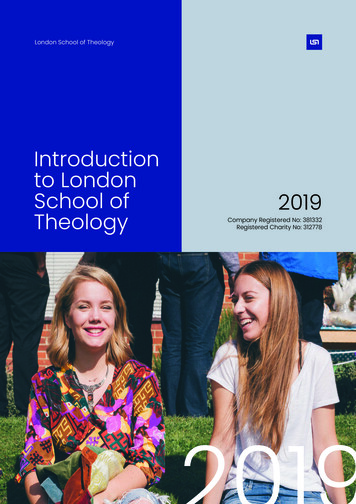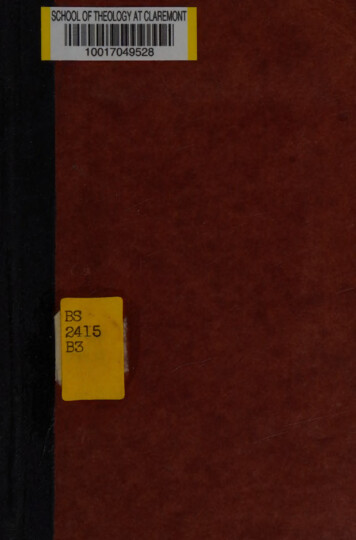
Transcription
SCHOOL OF THEOLOGY AT CLAREMONTHITE
a i! 0F GA L1)EiiAa Tian ‘Studyof ie-inJesusiDota: ‘of’- theFirst Three coreyeseeae Bartone ."Charle Meeague“The peor Le v3 s‘of the:iscopal Chureb MethodistEpae ape
THETEACHER OF GALILEE.e. IS. An Inductive Study of the Teaching3of Jesus in the First ThreeGospelsBYCHARLESM. BARTON
wllCopyrighted 1916 byThe Epworth League of theMethodist Episcopal ChurchTheology LibrarySCHOOL. OF THEOLOGYAT CLAREMONTCaliforniaUniversity of Sownern @utemie Liprarys.
orRaleguin o My Mother
ContentsPARTI. THE TEACHER, AND HIS BIOGRAPHERSAND REPORTERSCuapter I. A Portrait AND Its Patnter: A Brief Survey ofthe Gospel According to Mark.Cuapter II. Tur Brelovep PHysicIAN AND WHAT HE WROTE:An Introduction to the Study of the Gospel According toLuke.CuHaprer II]. Tue Story tHE PuHysic1AN Torp: Narrative Por-tions of the Gospel According to Luke.ECuHaprer IV. Tue Tax-CoiiEctor AND His MEMorRIEs OF THEGreat TEACHER: Narrative Portions of the Gospel Accordingto Matthew.CHAPTER V. THREE PAINTERS, ONE Portrait: An Introductionto the Study of the Synoptic Problem.PARTIl.THETEACHINGCuaprer VI. Tut Mountain Teacuine: An Introduction tothe Study of the Sermon on the Mount.Cuapter VII. Tut Mountain TEACHING, Concluded: The Message of the Sermon on the Mount and the Ethics of Jesus.CuHaAprer VIII. Tue Goop Tiprncs oF THE Kincpom: A Studyof the Great Hope and a Characteristic Phrase.Cuaptrer IX.THE RepEEMED Society: A Study of the SocialAims and Application of Jesus’ Teaching, Based LargelyUpon the Report of That Teaching in the Gospel Accordingto Luke.CHAPTER X.THE CoMING OF THE SON oF Man: Jesus’ TeachingRegarding Himself and the Future,
AeTo the StudentThe life and teachings of Jesus are for a Christian the supremestudy.-Far.more important than what others have written about theteaching of Jesus is the teaching itself.In the ten succeeding studies the student is led to investigatethat teaching for himself.Five studies are devoted to the sources of our knowledge ofthat teaching, the first three—called the “Synoptic’—Gospels,omitting from our studies the fourth Gospel, because of itsmarked individuality and its unlikeness to the first three.In each of these five earlier studies the attempt is made to getat the Gospel from its human side—the author, interesting factsabout his personality and history, his opportunity to know regarding the life and teaching of Jesus, his especial ndobjectofhiswriting, and the worth to us of the history he has written.The Gospel according to Mark, the briefest and simplest ofthem all, and almost wholly given over to the doings ratherthan the sayings of Jesus, is rightly studied first. In this studyyou will master the outlines of the life of Christ.Then, because the career of that. evangelist is so full ofhuman interest, and because the first four verses of his Gospelare the simplest possible introduction to the study of how andwhy our Gospels were written, the physician, Luke, and thestory that he wrote are made the subject of our second andthird studies.The Gospel according to Matthew is studied last, for it isitself mainly teachings rathef than narrative, and is thereforea natural transition to the study of the teachings of Jesus.The fifth study compares the first three Gospels, seeks to notetheir differences and individual message and value, and, yet moreparticularly, their likenesses, their one record of the IncomparableLife, and their one report of the supreme teaching.The five later studies consider the teaching itself.In the first two of these the Sermon on the Mount is made—as it was intended—an introduction to the study of Jesus’ teaching,in particular of his ethics, his account of moral duty, his picture of the Christian character, and his doctrine of God asFather.5
Another study considers the most characteristic phrase ofJesus’ teaching, “The Kingdom,” and seeks to define, as clearlyas we may, what the Kingdom stood for in our Master’s thought.Yet another study, devoted mainly to Luke’s report of Jesus,teaching, sets itself to discover, if we may, the social significanceof Jesus’ teaching, what he has to offer toward the solution ofproblems that vex our modern world: It seeks, also, to estimatethe great aim and purpose of his life and teaching: Was hereformer, teacher, philanthropist, evangelist?The last of this later group of studies asks what Testis meantby the name he so commonly applied to himself, “The Son ofMan,” and that other great name which a follower applied tohim—Did -he use it of himself?—“The Son of God.”It seeksto know what was Jesus’ thought concerning himself, and tolift, so far as he helps us to, the veil.of the future, and toknow what we may concerning the outcomes of the personallife, and of the world’s history.Of course,rangeof thesenotall that Jesusstudies:everbut nonesaid is broughtof the moreinto theimportantutter-ances, we venture to hope, has been passed by.Some of these studies suggest technical problems that may befound ‘difficult for the young reader: If he cannot solve them,or frame a reasonable theory, let him leave them for later years.There are simple tasks in every study, things which he cannotafford to miss.None of these studies can be spared from a conscientious effortto know the Gospels as they are, and to take an all-aroundview of Jesus’ teaching. But if it is thought desirable to shortenthe series to, say, eight weeks, the fifth study might be omittedwith the exception of the questions assigned for the sixth andseventh days—which should by no means be omitted; and fromamong the second group of five, the ninth study with theexception of the third and fifth days, can possibly better bespared than either of the others, though it would be a gravemisfortune to lose Luke’s distinctive note and the social andevangelistic passion of Jesus’ ministry.Onsomepagerealthe other hand, even at the cost-of lengthening the series,classes may wish to make out of the tenth study and theheaded, “In Conclusion,” two studies: though there is again in giving to so difficult a subject as Jesus’ teaching6
about his “Coming Again” a rapid survey, a sort of “bird’s-eye”view of the whole.Do not forget that you are coming to these studies to learnwhat Jesus has to tell us about life and duty and destiny. Youare to try to understand his words, not through the distortinglenses of theological controversy or popular opinion but, if youcan, just as Jesus thought it and meant it. You are to try toknow his mind.!This is really the object in every study of all the ten. Youare to study his biographers and reporters before you give attention to their report of what he taught. And you will study theirstory of his life. You wish to know the Teacher, so that youmay the better understand his teachings.And you wish toknow his biographers, so that you may discover the principleson which they selected their materials out of the greater massof his unrecorded labors and teachings.For “there are alsomany other things which Jesus did, the which if they should bewritten every one, I suppose that even the world itself wouldnot contain the books that should be written.”So, John 21:25,And certainly we may “suppose” that no less is true of “thethings” he said, though it be true that “all the recorded sayingsof Jesus could be spoken in six hours,’ (Hayes).Then,havingstudied the Teacherand those whowroteabouthim, you will study Jesus’ own words with all the keenness ofmind you can bring to the study—we honor him so—and withwilling hearts and hands and feet, asking to know the way oflife that you may walk in it, eager to learn the tasks he has foryou that you may do them, seeking to know his rightful claimupon you that you may yield him the devotion which is hisdue.“Speak, Lord, for thy servant heareth.”Lastly, bear in mind that this book is both guide and notebook. Dare to record in it day by day your own conclusions,though later you may wish to add to or revise or correct whatis written.Well-kept notebooks mean profitable individualstudy, and helpful class sessions.
To Leaders of ClassesIt is assumed that these studies will be pursued by groups in}classes.Much can be accomplished by the individual student workingalone. More can be accomplished by groups of students workaing together and correcting and broadening the results of their B:3individual study by the interchange of ideas in a weekly class aoasession of not less than sixty minutes.The key-man of any such class is of course the leader—hemay be a pastor—why might not any pastor count it a privilegeto lead such a class?—or he may be a professional educator, orhe may be simply an earnest student, chosen from among thegroup, and with no apparent advantage either in years or inprofessional training—Yourself.What a privilege is yours!What finer opportunity of usefulness might anyone covet thanto lead a group of eager young folk in the earnest, constructivestudy of the teachings of Jesus?A first essential of the leader’s preparation is to master theplan of these studies. He should himself read, and advise, even eeeeeTPEpeurge, his students. to read the foreword, “To the Student.” Heshould go carefully over the whole of these outline studiesbefore the work with the class is even begun, that he may 7esaaaoknow the end from the beginning, and the road to the end.A second and no less important element of the leader’s preparation is to know the subject-matter of these studies. He shouldbe willing—at least, in hurried review: if possible, with somethoroughness—to go through these studies in advance, just ashe will expect his students to do afterward, learning from theGospels themselves what the Gospels are; and from Jesus’ teachings, what Jesus taught.To make possible such an effective preparation of himselfon the leader’s part, it is well that, whenever possible, leadersof prospective classes should be chosen some months in advanceoftheample,timeappointedin preparationfortheclass—inpaign.A third element ofand approve of thewhich is:—The Bible,books about the Biblemid-summer,for a fall or winter’sBibleforex-study camsthe leader’s preparation is to understandfundamental principle of these studies,its own interpreter; the Bible first, andafterward.8me
The first study of the present series rapidly reviews a formertext-book of similar character, “The Earliest Portrait of Jesus:An Inductive Study of the Gospel According to Mark,” ‘a thorough mastery of which is a splendid preparation for the presentseries. See same and pamphlet of suggestions for leaders.A helpful list of the briefer best books (simple yet scholarly,both modern and devout) for the use of both students andleaders, is given in connection with the first study. Leaders, however well informed, will find these brief and simple studiesexceedingly helpful. Indeed, they may well be made the basisof all the leader’s reading. Other books of-a similar characterare suggested in connection with succeeding studies.Theselibrary references and citations are intended to be used onlyafter, never before, the student has given to the Gospel his ownbest efforts: they are not crutches meant to spare the studentthe labor—and profit—of independent thought; they are an offering—and “reward of merit”—to enrich the already great gainsof the student who has spent the week, not with what the scholars' have written, but with the Great Teacher Himself and withhis reporters and biographers.Let the leader insist on thisorder:the Biblefirst, a personalstudyof it, thenwhatbooksmay add.To the list already mentioned may be added the followingmore extended and more difficult volumes—and therefore lessadapted to the general reader—from some of which the compiler of these studies has received much help, and which willbe of service to those leaders of classes, and pastors, who shalldesire to make a thorough investigation of the problems thatmay arise in a study of the Gospels and the teaching of ourThey represent the ripest scholarship of to-day, areLord.modern and devout, and can be found in many pastors’ andpublic libraries. But, take notice, the mere fact that any bookis recommended in this or other lists, does not imply that therstoaccept, all of its conclusions.Hastings, “Dictionary of the Bible,” five volumes, an acknowledged standard, ( 30.00).“The International Standard Bible Encyclopedia,’J. Orr, editor;a recentlyannouncedworkwhichthe presentwriternot had the opportunity to examine; highly recommended;servative in opinion.9hascon-
Hastings, “Dictionary of Christ and the Gospels,” two volumes,a very great work, ( 12.00).aeGould, “St. Mark,” in “The Internationaltary,” a really great commentary, ( 2.50).Plummer,“St. Luke,” same series,CriticalCommen-( 3.00).Allen, “St. Mathew,” same series: largely concerned withcritical problems, ( 3.00).Plummer, “An Exegetical Commentary on the Gospel According to St. Matthew,” called “the best handbook in Englishfor serious study of the first Gospel,” (Buell), ( 3.00).Wendt, “The Teaching of Jesus,” an elaborate study in twovolumes, ( 5.00); one of the masterpieces of German scholarship.Forrest, “The Authority of Christ,’ ( 2.00).Garvie, “The Inner Life of Jesus,” ( 2.25).King, “The Ethics of Jesus,” ( .60 and 1.50).Stalker, “The Ethics of Jesus,” ( 1.75), and “The Christologyof Jesus,” ( 1.25).(These two and the preceding volume arebased upon the Synoptic Gospels.)Savage, “The Gospel of the Kingdom,”( 3.50).Mathews, “The Messianic Hope in the New Testament,”( 2.50), and “The Social Teaching of Jesus,” ( 1.65).The most vital element of the leader’s preparation, it remainsto be said, is, of course, personal and spiritual.Let him notneglect to pray, to saturate all his studies and his leadership withprayer. The most thorough, even the most daring, investigationof New Testament problems is not inconsistent with the mostintense and humble prayer. If all his studies, and all the laborsof the class, cannot ultimately be brought back into life toenrich it, the student’s researches, his leadership, and the author’slabors will have been in vain, and less than in vain. From allour studies of the life and words of Jesus, we ought at lengthto come back saying, like Richard Watson Gilder’s “HeathenSojourning in Galilee, A. D. 32,”“Tf Jesus Christ is a man—And only a man—I sayThat of all mankind I cleave to Him,And to Him will I cleave alway.10
-“If Jesus Christ is a God—And the only God—I swearI will follow Him through heaven and hell,The earth, the sea, and the air.”Or, like the Twelve,“Lord, to whometernal life.”shallwego?11Thouhastthewordsof
PART“WereI.THe TEacHER,AND His BiocRAPHERSANDREPORTERSthe Gospels inventions, whether mythical or marvelouscreations of literary art which we possess. The underlying ideais majestic, sublime, complex, but the history which embodies itis simple, sober, sane, while the person in whom and by whomit is realized is the most natural and human character in allliterature.”.—A. M. Fairbairn.“The compilation of the Gospels is, next to the personal actionof Jesus, the leading fact in the history of the origins ofChristianity—I will even add, in the history of mankind.”—Renan.
Stupy I.A Porrrarr anp Its Parnter: A Brief Survey of theGospel According to St.:Mark“The briefest of the Gospels,the simplest of the books of the New Testament,(which) brings us nearest to the feet of the Master:This primitive picture of the Incarnate Life.”—H., B. Swete.“ Lord and Master of us all,Whate’er our name or sign,We own thy sway, we hear thy call,We test our lives by thine.”—J. G. Whittier.13
Read the Gospel according to Mark throughout, dividing itscontents according to the following plan:ReadHirst aD ay, -conics avatitarstaaietacalisin seth otek ereiees Markel li togsoen0Second: Dayivina. Be SIGs Seat erate goolac te Ree ieBi ietoscoE4Shinds Days siaccmwsiekecentac ice sealt aietetsOc lsto: 723Gurl MO ays cone cudepese exe faders,s SONS ae BROS7:24 to 9:29Pasthe Way os ci ole ores: askedow oa eee9:30 to 11:19Sipsthe aye asta «icine aes Shae ee ees see11:20 to 13:37Seventh Day: (i. eee Senattee pie eee aan14: 1 to 16: 8**Seemarginalnoteon16:9.The use of the American Standardstudies is strongly recommended.Version throughout theseQuestions for private study and for discussion in classAfter each day’s reading, note and write out answers or partialanswers discovered for any of the following questions.Blankspaces are provided for the student’s answers.Complete thewritten work as nearly as may be possible before the classsession.What is the outstanding impression which a first reading ofthis book makes upon you?14
you?What is the picture of Jesus which this book givesment orAre you able in Mark’s narrative to trace any developofmethodtheinortancescircumsdoutwarchange either in theJesus’ ministry?15
On the accompanying outline map trace the journeys of Jesusof which Mark’s Gospel tells is.16
How many journeys are recorded in this gospel?And what more important events happened on each journey?Thus:First Journey: Nazareth, to Jordan, Wilderness, Capernaum.Baptism.Temptation.First Disciples.Complete the analysis so begun.
How many and what miracles are particularly described in thisGospel?What impression is given of the total number of miracles whichJesus wrought?18
Are any considerable sections of this Gospel given over wholiyto the words rather than the deeds of Jesus? Which are they?How many and what parables occur in this Gospel?What are the favorite themes of Jesus’ teaching?Is there any difference to be noted in the themes concerningwhich Jesus spoke in the earlier and later periods of his ministry?19
What is this writer’s favorite word?How many times does it occur?Whatis his favoritetense?Cite examples.What are somewhat he wrote?Cite examples,other meansby whichhe gave vividnessto
Tradition asserts that this Gospel is the work of John Markof Jerusalem. For his life story read Mark .14:51, 52 (?), Acts12-12% 25,.13 23, 13, 1536-41; Philem.\23, 24 Col. 4:10, 11; 2.Tim.411 1 Pet. 5:13.From these brief hints rebuild the fascinating story of “JohnMark, the Youth Who Failed Once, but Won.”21
Do the facts of Mark’s life explain any of the characteristicqualities of his writing? If so, how?Is there good reason to believe the tradition true?23
What is the historical value of Mark’s Gospel?From Mark 15:21 (compare Rom. 16:13) what inference mightbe drawn as to the readers for whom this Gospel was originallyintended ?Is the general character of the Gospel such as ie give to thissupposition the color of truth?See also, for whatever light they may throw upon the question who were the Gospel’s first readers, (a) Mark 3:17, 5:41,7:11, 34, 10:46, 14:36, 15:22, 34; (b) Mark 7:2-4, 12:42, 13:3,14:12, 15:42.24
UNDER THE LIBRARY LAMPIt shall be the effort of the writer of these studies in paragraphs bearing this heading to suggest brief supplementarystudies, suited to younger readers; adding occasionally briefillustrative citations from-some of the fresher, newer literatureupon the subjects studied.N. B.—These citations and library references are intendedto be read only after the student has given to an independentstudy of the assigned Scripture portions and questions his ownbest effort, never before.A one-volume Bible dictionary, Hastingsboth of them works of considerable merit,great value throughout these studies.or the Standard,will be found ofValuable series of brief and inexpensive pocket-commentariesare “The New Century Bible’ (N. C. B.) published by Frowde;“The Westminster New Testament” (W. N. T.), Revell; “TheBible for Home and School” (H. & Sc.), Macmillan; and “The‘Cambridge Bible for School and College” (Camb. B.), Macmillan—hereafter referred to by the abbreviations indicated in bracketsabove.Alimited but very useful reference library to accompanythese studies might be constituted, at slight cost, as follows:Huck’s “Synopsis of the First Three Gospels,” pp. 171, 1.00;or Stevens and Burton, “A Harmony of the Gospels for Histor-ical Study,” pp. 263, 1.10 ppd.Salmond’s “St. Mark,” (N. C. B.), pp. 377, .85 ppd.D. Smith, “St. Matthew,’ (W. N. T.), pp. 256, .75 ppd.; orRobertson, “St. Matthew,” (H. & Sc.), pp. 294, .70 ppd.; orWeston, “Matthew, the Genesis of the New Testament,” .20ppd.Hayes, “The Most Beautiful Book Ever Written,” pp. 183, .75;or Adeney, “St. Luke,” (N. C. B.), pp. 404, .85 ppd.; or Garvie,“St. Luke,” (W. N. T.) pp. 384, .75 ppd.Hayes, “The Synoptic Problem,” pp. 87, .35.Stevens, “The Teaching of Jesus,” pp. 190, 1.10 ppd.; orAlexander, “The Son of Man,” pp. 380, .70.It is not to be supposed that the purchase or reading of thebooks named in the above specially selected list, nor in latersupplementary lists, is required in order to a successful use ofthese “Studies.” But a wise use of the suggested readings can25
no doubt be made greatly to enrich the results of the student’spersonal efforts. The earnest student will do well to learn earlyin the course what reference books are accessible to him. inpublic and private libraries:For his assistance, in case heshould wish to buy, the number of pages and price of each bookto which reference is made in any of these lists:are also given.For the present “Study,” the introduction, pp. 2-48, to Salmond’s “St. Mark,” (N. C. B.), will. be found especially helpful.See also articles, “John Mark,” and “The Gospel According toMark,”in Bible dictionaries.“The general character of its narrative, so life-like, so definiteand assured in its statements, in the case even of small things,points an eye-witness as directly or indirectly its author.“Tt is not a product of art, nor is it a work of reflection. It isa record of facts as they literally and really were.”—Salmond.“As the earliest Gospel, written when the facts were yet freshin Peter’s memory; as the Gospel resting upon Peter’s authority,the authority of an eye-witness; as the Gospel which seems freestfrom afl philosophical and theological prepossessions, the second Gospel is generally recognized by modern scholarship as the mostauthoritative of all the evangelical narratives.There was atime when it was the most neglected and the least valued ofthe Gospels.Now it ranks before all others as an historicaisource and a reliable basis for all further study.”—Hayes.26
STUDYII.Tue Betovep Puysician AND WHatHE WRrore:An Introduction to the Study of the Gospel According to Luke“Thatlife beautifulhad to be writtenby a soul beautiful as they.”;into a bookbeautiful5—D. A. Hayes.2/
First DayRead and compare Luke 1:1-4 and Acts 1:1-5. In what respectare these two documents unique among the historical books ofthe New Testament?What important inference do you draw from these twodedications?From what is furnished you in these dedications reconstruct,‘so far as you can, the world in which their author wrote.Who, probably, was Theophilus?28
Second DayIn certain portions of the book of the Acts the story is told inthe first person plural—Acts 16:10-18, 20:5 to 21:18, 27:1 to28:16.Hence these are known as the “We” sections of thebook of Acts, the “travel document,” or the “diary.”Hunt for the pronouns “we” and “they” as applied to Pauland his party (a) in these sections, (b) in other portions ofthe same book.(Perhaps the gap, 21:19 to 26:32, is seemingrather than real—why?And quite likely this portion, too, andthe concluding paragraphs, 28:17-31, should really be counted apart of the “We?” sections).What do you infer as to the authorship of these sections? ofthe book in which they occur? of both books?What of the author’sthese passages?personalhistorydo yougatherfrom430
eSgts2)is
Third DayThis Gospel has long borne the title, “According to Luke.”Certain letters of Paul mention one “Luke”: read Col. 4:10-14,Philem. 23, 24, 2 Tim. 4:11. (2 Cor. 8:18, 19 may also contain areference to Luke, only not by name.)From the name, his profession and the statements made concerning him, what do you infer as to this man’s nationality—contrast him with what you know concerning the other writersof the New Testament—his education, personal history andcharacter ?:What is known concerning the development of the medicalprofession during the first Christian century?Why did this physician accompany Paul?(Compare Gal.4:13-15, Acts 27:2, A. S. V., margin.See also Acts 16:10, 13,14, 17, Philem. 24.)«i F32iXZ
Fourth DayCould this physician, Luke, have been the author of these twodocuments, “the Gospel According to Luke,” and the “Acts”?Is there anything in the character of the book itself to makesuch a theory credible? Thus :—(a) Is it probable that its author was a non-Jew, a Gentile?(b) Is it probable that its author was a physician?Whatindication of that fact, if any, do you find?(c) Is it probable that its author was a friend and companionof Paul? What trace, if any, do you mad in this Gospel of theinfluence and thinking of Paul?With these questions in mind read Luke, chapters 4 and 5.Continue this same search in the next study.‘)34So,
Fifth DayWhat was the author’s effort and purpose in the writing of thisGospel? Study the dedication and preface (or “prologue,” 1:1-4)of his Life of Jesus, the “Gospel according to Luke.”How did this authorJesus’ life?prepare36himselfto write the story of
Sixth DayWhen, where and how had Luke, the friend and companion ofPaul, opportunity to gather the materials of his Gospel?(Compare the “We?” sections of his Church history, the book of “theActs.” Thus, 21:8, 9, 15-18, 24:27. Also Col. 4:10-14.)From what oral sources may he have drawn?(See aboveand Luke 2:19, 33, 51, 8:1-3, 23:8-12, 24:10.)What earlier written narratives is it likely he had at hand?(Reread Luke 4:31-44, and compare Mark 1:21-39. See also Col.4:10-14, Philem. 24, 2 Tim. 4:11.)37
Seventh DayTo the story of Jesus’ life as given in Mark’s Gospel, Lukeadds one lengthy narrative portion, 1:5 to 2:51. Give it a name.Another yet more lengthy section, sometimes spoken of asthe “travel document,’ 9:51 to 19:28, is mainly devoted to theteachings of Jesus loosely strung together upon a meager threadof narrative.Where are these teachings apparently supposedto have been spoken?Sy.38
UNDERTHELIBRARYLAMPD. A. Hayes’ delightful volume, “The Most Beautiful BookEver Written,” (pp. 183, .75) begins so: “Luke is one of themost lovable characters in all Church history. The Gospel according to Luke is one of the most attractive books in the world’sliterature.Reader, have you thought you knew the Evangelist Luke?” To justify this appreciation and put us on termsof close acquaintance with the kindly physician of whom therugged apostle to the Gentiles spoke in unwonted terms ofaffectionis theaimwhichthiswhich effort he has signallywith this study, pp. 1-67.writerhassucceeded.set himself,ReadExcellent brief commentaries are Garvie .75) and Adeney (N. C. B., pp. 404, .85).andinin connection(W. N. T., pp. 384,“The Gospel of St. Luke is rightly styled ‘the most literaryof the Gospels’ (Renan).‘St. Luke has more literary ambitionthan his fellows’ (Sanday).He possesses the art of composition. He knows not only how to tell a tale truthfully, but howto tell it with effect. He can feel contrasts and harmonies, andreproduce them for his readers. The way in which he tells thestories of the widow’s son at Nain, the sinner in Simon’s house,Martha and Mary at Bethany, and the walk to Emmaus, is quiteexquisite.And one might go on giving illustrations of hispower, until one has mentioned nearly the whole Gospel. Thesixth century was not far from the truth when it called him apainter, and said that he had painted the portrait of the Virgin.There is no picture of her so complete as his. How lifelikeare his sketches of Zacharias, Anna,-Zaccheus, Herod Antipas!And with how few touches is each done!.As the fine literarytasteofRenanaffirms,it is themostbeautifulbookin theworld.”—Plummer.’“Dante called Luke ‘the writer of the story of the gentleness of Christ,’ and only a gentle and lovable spirit could havewritten a story so beautiful in style and in content as this.”—Hayes.39
“It is as good as certain from the subject-matter, and moreespecially from the style of this great work that its authorwas a physician by profession.”—Harnack.“Luke did not derive any of his materials from Paul, but whocan doubt that Paul’s influence determined his choice of someofhismaterials?Hisuniversalism,if notentirelyduetoPaul, but to his Gentile birth, was confirmed by his intercoursewith the Apostle to the Gentiles. And in his universalism we mayinclude his interest in the outcasts of Jewish society, as well asthe Gentile and the Samaritan.His interest in Samaria mayhave had an additional reason, as Harnack suggests, in hisintimacy with Philip the Evangelist.”—Garvie.The MaterialsFromof Luke’sMarkNot from MarkTeletoy. 225l3 :23-385: 1-116:20 to 8: 39:51 to 18:1419: 1-2824 312-53—Adapted from Adeney.3: 1-224: 1-445:12 to 6:198:4 to 9:5018 :15-4319:29 to 24:11“Onefactstandsfast:Gospelthe thirdevangelistcopiedtheworkof the second.Nearly three-fourths of the text of St. Mark‘appears again in St. Luke, and throughout almost exactly inthe Markan order.”3—Harnack.40 ;
STUDYIII. THe Story tHe Puysician Torp: Narrative Portions of the Gospel According to St. Luke“This Gospel of the Saviour of Sinners.”—Harnack.41
ReadFirst Day, Luke 1:5 to 2:52, The Gospel of the Infancy.Second Day, Luke 3:1 to 5:16, The Galilean Ministry.Third Day, Luke 5:17 to 6:19, 7:1 to 8:21, the same, continued.Fourth Day, Luke 8:22 to 9:50, the same, concluded.Fifth Day, Luke 9:51-62, 10:1-21, 25, 38-42, 11:1, 14, 27, 29, 37,53, 54.12 1. 13, 1321) O17, 22,23. 30-355 14 71-4,525, E52,17:11-19, 18:18-23, 31-43, 19:1-10, 28, The Perea
THE TEACHER OF GALILEE. e. IS. An Inductive Study of the Teaching 3 of Jesus in the First Three . Methodist Episcopal Church Theology Library SCHOOL. OF THEOLOGY AT CLAREMONT California University of Sownern @utemie Liprary wll s. or Raleguin 232.9 B293t ransferred i} Ss "ete VUNG) NH NE BE Pere ae QT To My Mother . Contents PART I. THE .
